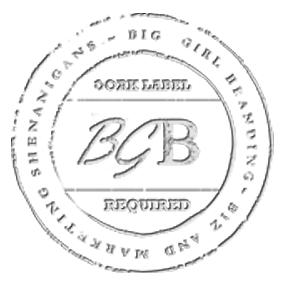This is another guest post by dear James. I thought it suitable as we discussed colors and branding earlier in the week.
Now James will talk to you about designing a killer poster that can then be printed out and used shamelessly as a wicked promo tool for your biz. And incidentally, colors happen play a huge role in their creation! 😉
If you’re a person who enjoys designing posters, you can create posters for your own hobby or business projects or earn an income making posters for other people. Once you’ve created a printable poster, which is an image file, you can display it on a website, print it out on your own printer and then photocopy it, or send it via email for others to print off their home printer.
The things you’ll need to start designing a printable poster are an image editing program, an online picture editing utility, a scanner, a website, a creative mind, and an artistic eye.
Here are 10 tips to creating an awesome printable poster:
#1. Before starting your poster, get inspired.
This means reviewing posters that you find online. Consider your own personal definition for “beautiful” and “ugly,” “clear” and “gaudy”, “orderly” or “chaotic.” Make a list of design elements that you like, incorporating them into your original ideas. Visit design blogs to find posters that inspire and help shape your own works.
#2. Use an editing program to begin.
You can choose Gimp, ImageReady, Adobe Shop, or any other similar program. Using one of these programs, you can create simple lines and curves or create complex art by combining many layers into a single image. Your choice of poster design depends entirely on your artistic inclinations. Once you’ve created your poster design, save the files using the JPEG format, which are 300 dpi or greater high resolution, in RGB color mode.
#3. Online editors.
If you are only interested in a simple printable poster, a second alternative is an online picture editing utility. All you have to do is open a picture and add text, other digital pictures, or clip art on top of it. Again, be sure to save a high resolution file in RGB mode.
#4. Scanning artwork.
A third alternative is to scan your artwork if you like to draw. You can select from a variety of scanner software and many have picture editing utilities. Once again, save your work in a high resolution file in RGB mode.
#5. Sort the wheat from the chaff.
In designing your poster, you should take some time to sort through various type faces to select the ones that best represent the message of your poster. A general rule of thumb is to use readable type for information-rich posters, stylish type for announcement-oriented posters, and experimental fonts for decorative-type posters.
#6. Colors.
The colors you use also deserve a lot of consideration. Choose colors that work in harmony with each other. If colors clash, your poster will look ugly. If they blend, your type face choice, contextual message, and graphic images are enhanced. Often you will need to use the color wheel to get just the right shades, rather than just rely on the default color choices.
#7. Images are super important.
The images you select are also part of your message. This is why you have to spend time getting just the right blend between the symbolic meaning of the images and the written message you wish to deliver. The image should also work well with the type of font that you select.
#8. Negative space.
Your poster should have some negative space to allow the images to breathe and the message to stand out. If for example, you have a lot of colour, there should be some white space to avoid a cluttered look.
#9. Avoid overdoing the elements in your poster.
For instance, your wording should be to the point, you should only have enough images to convey your idea, and you should not have an excessive choice of colours. White space and empty places in your poster will allow viewers to focus on your essential elements. In other words, prefer minimalism to baroque designs.
#10. Outlines.
As a guide for the person who wants to print out the poster, use an outline for the cutout. You can use stroking, which means adding dashed lines. It’s advisable to leave a white space of half-an-inch around the image border.
Bonus Tip
The ideal size for your poster is 800 x 1000 pixels. This works well in a web browser and it also creates a good-sized printed poster. Keep the print resolution at 300 dpi. This assures the best print quality.
Once you’ve created the poster, you can upload it to your website files, send the link to your poster customers, or print it out on your home printer. If you are sending the poster to someone for printing, add a few instructions on how to print out and cut the poster.
Thoughts? Comments? Drop them below and let’s discuss. And if you found this post useful, please be sure to spread the love around.

